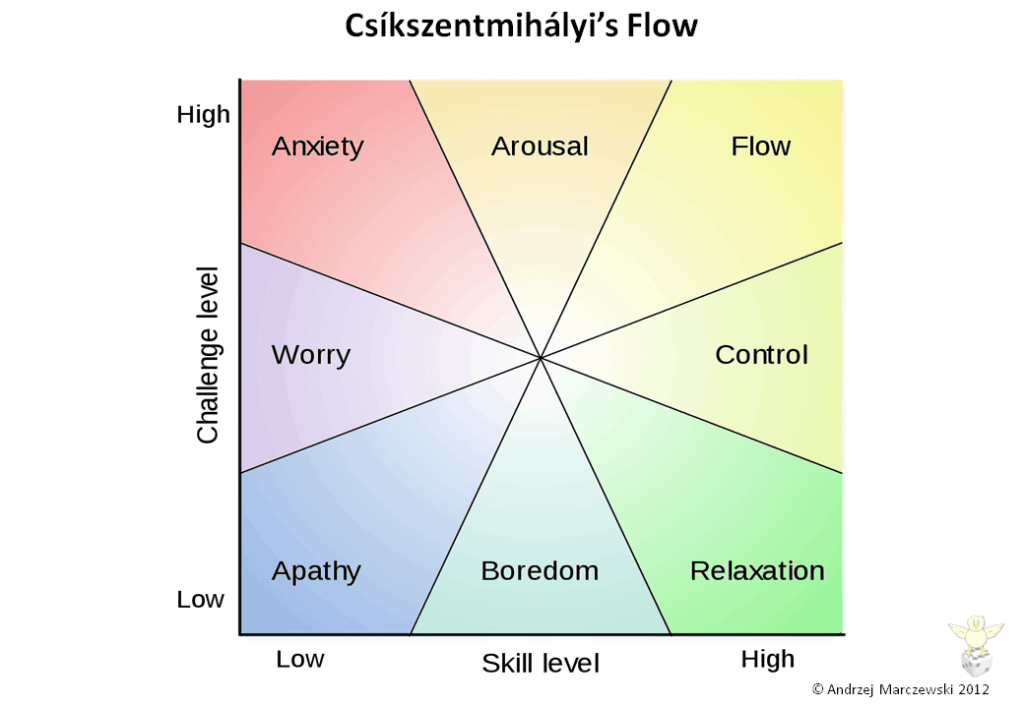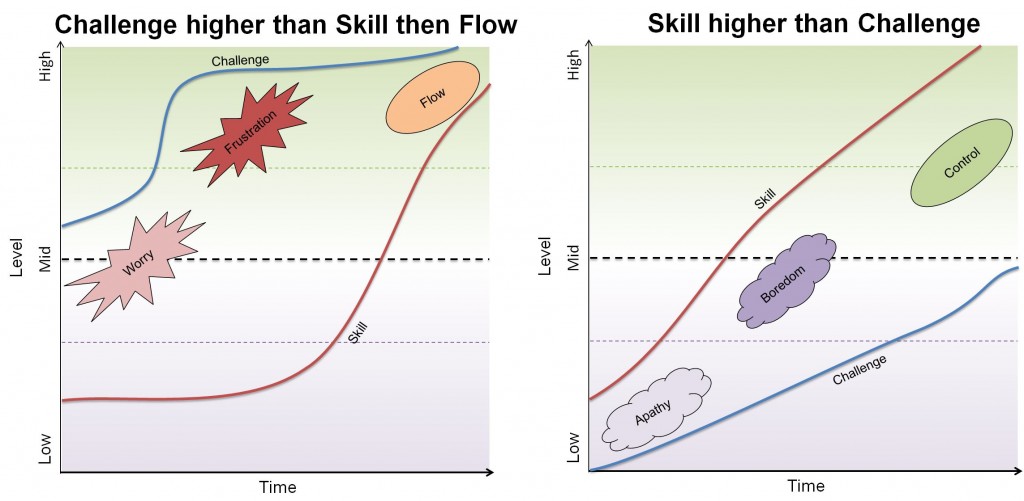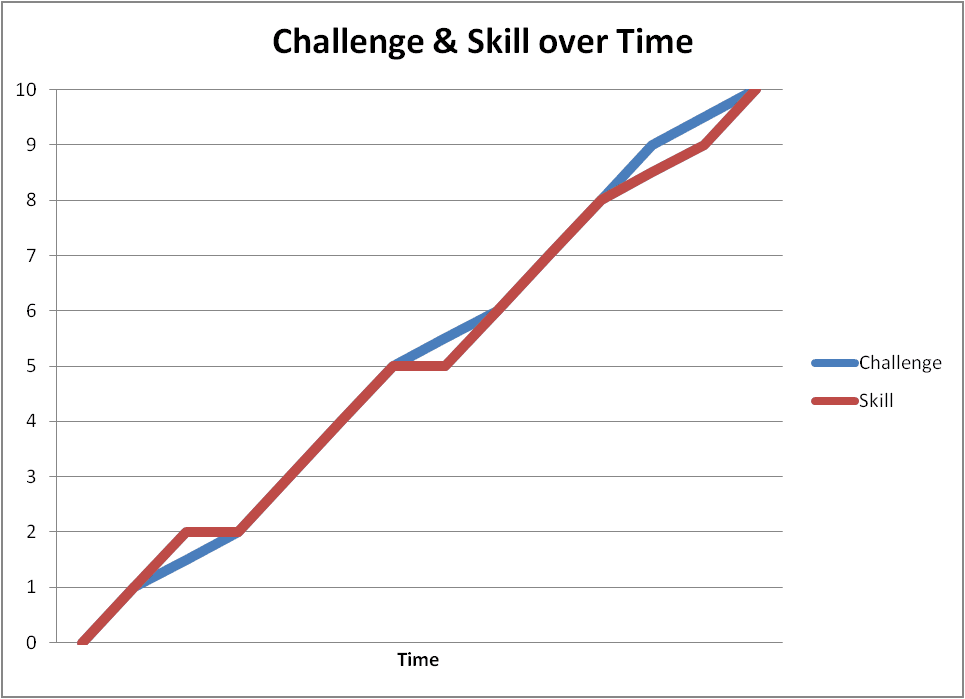Flow. A popular concept in gamification, goodness knows I have spoken about it often enough – just last week in fact. It was that article that actually made me realise that there is a distinct misunderstanding of flow as Mihály Csíkszentmihályi describes it.
The image below is how we in gamification tend to view it, our simplified version.
 We talk about the Flow Channel, the point where skill level and challenge level are in a good balance. So this would mean that Flow could be achieved when you have a balanced low skill and low chalenge. However, when we look at how Mihály Csíkszentmihályi originally described it, that would actually be apathy – not a state we want for our users!
We talk about the Flow Channel, the point where skill level and challenge level are in a good balance. So this would mean that Flow could be achieved when you have a balanced low skill and low chalenge. However, when we look at how Mihály Csíkszentmihályi originally described it, that would actually be apathy – not a state we want for our users!
 I think and I know this is true of me, that we are actually talking about a balance of skill and challenge over time. Flow theory is about a particular moment in time – a snapshot.
I think and I know this is true of me, that we are actually talking about a balance of skill and challenge over time. Flow theory is about a particular moment in time – a snapshot.
For gamification to work, we want to increase the level of challenge in line with the level of skill our users have. The idea being that they develop new skills as new challenge arise. To high a challenge with to low a skill level and boom! – they get frustrated, the other way around and wham! – boredom.
So, lets consider Challenge vs Skill over Time. The image below is similar to the ones I used in my article last week. It shows two lines. One is skill and one is challenge. It shows the ‘ideal’ balance as I have just described. Over time, challenge and skill increase in a parallel way.
 The points where the lines converge at the high skill relative to challenge level could be potential points of Flow. This brings about a slightly different approach to working out where boredom and frustration occur – something I got wrong in my last article on this actually!
The points where the lines converge at the high skill relative to challenge level could be potential points of Flow. This brings about a slightly different approach to working out where boredom and frustration occur – something I got wrong in my last article on this actually!
If the skill level drops too far below the challenge level for a period of time – that is when you get frustration. If the challenge is below the skill levels – that is when you can get boredom.
 So the graphs would look a little like this – left is frustration (lower skill relative to challenge), right is boredom (lower challenge relative to skill). I know, I know – this is way more complex than the nice simple flow diagram we have all been using, so I don’t expect anyone to adopt this – but, it seems to be more correct!
So the graphs would look a little like this – left is frustration (lower skill relative to challenge), right is boredom (lower challenge relative to skill). I know, I know – this is way more complex than the nice simple flow diagram we have all been using, so I don’t expect anyone to adopt this – but, it seems to be more correct!
Just for fun, I have plotted a few of the other areas of the original Flow diagram on the same chart type. Time is a little less important, but the position of Skill and Challenge is!
 The point to all of this is, Flow was never meant to be represented as Skill and Challenge over time – the simplified diagram we have all be using is misleading in this respect. Flow is a moment when perceived skill and perceived challenge are both above the median (note not just high) and they are well balanced. However, there is more to it than that!
The point to all of this is, Flow was never meant to be represented as Skill and Challenge over time – the simplified diagram we have all be using is misleading in this respect. Flow is a moment when perceived skill and perceived challenge are both above the median (note not just high) and they are well balanced. However, there is more to it than that!
From his book Handbook of Competence and Motivation;
- One must be involved in an activity with a clear set of goals and progress. This adds direction and structure to the task.
- The task at hand must have clear and immediate feedback. This helps the person negotiate any changing demands and allows them to adjust their performance to maintain the flow state.
- One must have a good balance between the perceived challenges of the task at hand and their own perceived skills. One must have confidence in one’s ability to complete the task at hand.
If we can build out solutions to avoid apathy, boredom, worry and frustration – then we are on to a winning track! To do this, keep re-enforcing the users level of skill, let them know what it is and give them the confidence that it is a match for any challenge they may have ahead.
According to Flow theory, as long as the perceived skills of your user are high compared to the challenge, then the worst that can happen is they will experience relaxation, but at least aim for control!
Extra – A likely more realistic path / journey!
I have used me EEEE Framework to show a possible user journey as well.
Also – there is an assumption here that skill will increase over time – this is of course not true. I use it as a way to illustrate systems aimed to help increase skills over time – not just because of the challenges!





Great info. Lucky me I found your site by chance (stumbleupon).
I’ve saved it for later!
Ville Killku left me the following comment – that I seem to have lost somehow!
There is one thing is dislike about your graphs: the relationship
between the level of challenge and skill development. Why does facing an
extremely difficult challenge eventually develop skill? Why are skills
improved by repeatedly solving a simple challenge?
Of course, in order to answer this, we’d need to venture deep into learning theory.. Is this going to be about gamification anymore, if we do that?
Be that as it may, I’ll throw in one mostly unfounded idea based on
some intuition and a superficial understanding of psychology:
1. The challenge has to be of a proper level for a learner in order
for learning to take place. Let’s throw in Vygotsky’s zone of proximal
development (http://en.wikipedia.org/wiki/Zone_of_proximal_development).
2. We can build a “game” that helps the learner solve those problems
that he can solve assisted, but not unassisted, resulting in optimal
learning.
2.1 The game determines the skill level of the learner based on criterion-referenced tests (http://en.wikipedia.org/wiki/Criterion-referenced_test) and the Rasch model (http://en.wikipedia.org/wiki/Rasch_model), and thus is able to help the learner appropriately. We use game mechanics to improve short-term motivation.
3. At sufficiently high levels, help remains available, but we move more towards uninterrupted learning and potential for flow experiences. Motivation becomes internal.
Was there a point to this story? Maybe that flow can be a useful user experience concept at higher skill levels, and that gamification can help pave the road to that level. *shrugs*
My Reply
I am not saying that a challenge increases skill. I am assuming that the
system is built to help you develop the skills needed to face the
challenge. I am saying that you need to keep the users perceived skill
levels in line with the perceived level of challenge. Didn’t make that
very clear though, so have noted it
There is one thing is dislike about your graphs: the relationship between the level of challenge and skill development. Why does facing an extremely difficult challenge eventually develop skill? Why are skills improved by repeatedly solving a simple challenge?
Of course, in order to answer this, we’d need to venture deep into learning theory.. Is this going to be about gamification anymore, if we do that?
Be that as it may, I’ll throw in one mostly unfounded idea based on some intuition and a superficial understanding of psychology:
1. The challenge has to be of a proper level for a learner in order for learning to take place. Let’s throw in Vygotsky’s zone of proximal development (http://en.wikipedia.org/wiki/Zone_of_proximal_development).
2. We can build a “game” that helps the learner solve those problems that he can solve assisted, but not unassisted, resulting in optimal learning.
2.1 The game determines the skill level of the learner based on criterion-referenced tests (http://en.wikipedia.org/wiki/Criterion-referenced_test) and the Rasch model (http://en.wikipedia.org/wiki/Rasch_model), and thus is able to help the learner appropriately. We use game mechanics to improve short-term motivation.
3. At sufficiently high levels, help remains available, but we move more towards uninterrupted learning and potential for flow experiences. Motivation becomes internal.
Was there a point to this story? Maybe that flow can be a useful user experience concept at higher skill levels, and that gamification can help pave the road to that level. *shrugs*
I am not saying that a challenge increases skill. I am assuming that the system is built to help you develop the skills needed to face the challenge. I am saying that you need to keep the users perceived skill levels in line with the perceived level of challenge. Didn’t make that very clear though, so have noted it 🙂
I like this post so much. But thinking about this question…..don’t you believe that both lines would have, in time, crossing points instead of moving in parallel? If there is always an offset, depending on the attitude or intrinsecal motivations of our player, of course, it could create again boredom or, specially, frustration…An example: I play to Football Manager, and I want to buy a superstar player but the owner club doesn’t sell him whatever the offer, or my negotiating tricks: I can be a great skill but the challenge become impossible…so I re-start the session (a sort of frustration). If the game offers me some moments of coincidence skill/challenge, maybe the flow is better and for ever……or I’m wrong? WHat’s your opinion? Thanks.
Absolutely. I am using extremes to highlight potential issues. In reality I am sure most applications would look a bit like this!